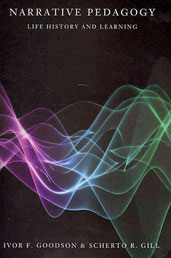Narrative Pedagogy
Learning and Narrative Pedagogy
Note that this is not a ‘stage theory’ or a hierarchical pattern but rather an endless spiral. People join at different points of the cycle and move in a spiral manner, revisiting themes or experiences. Some life stories move into theorisation: a more abstract understanding of a person’s stories, which is a bridge between what has been reflected, philosophised and articulated and their own life. This transition can provide a take-off point for developing a strategic approach to living a good life (which for us is in the Aristotelian sense), or articulating an integral narration where the person presents a holistic sense of themselves, and assumes a direction in life that shows their integrity. Our sense is that moving through location, theorising and integrity are the points at which narrative learning may become transformative. Transformative in the sense that one can now begin to live an examined life (in the words of Socrates), a good life. But we stress that integrity is not the final end point – it is a point on the journey. New conditions and transitions begin the spiral of learning once again.
One way to understand the transformative process of theorising a life and developing an ecological sense of selfhood is by an analogy with grieving. In both processes a person has to come to a more detached (theorised) view of their situation and in the process of acceptance develops a more holistic sense of their personal vision. We saw this process at work with a number of the life storytellers in our research and teaching experience as they came to the later stages of their lives. In Christopher’s process, for instance, as detailed in Chapter Four, he began to understand his own life story in a new way as he came to terms with his own mortality. In a sense he is grieving for his heroic self, the self that carved out a life project in the face of childhood trauma. As well as grieving he is coming to a new acceptance of life. It is an acceptance that life could be lived without the overwhelming and commanding voice that had dominated his inner conversation for the majority of his life. This was the voice of his childhood fears and monstrous self-blame. Through location and theorisation he came to see the limits of his overarching individual narrative and to craft a new and holistic vision of selfhood.
Whilst a pattern of selfhood is being deconstructed with acceptance, a new narrative of selfhood begins to emerge. In this sense ‘acceptance’ becomes a major pedagogic threshold. Often, acceptance is linked to an understanding that private, individual issues are part of broader human concerns. This linking of the individual to the wider ‘common stream’ of humanity moves a person’s narrative forwards. The reconciliation moves through two milieu: firstly, the reconciliation with each individual’s own personal stories and psychic landscapes, a process of coming to accept who we are, and why we have storied the world in the way we have; and secondly, a broader sense of reconciliation with the wider world and the multi-faceted human condition.
